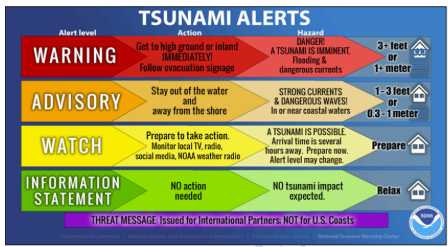
- Services
- Government
- Opportunities
- Culture
- News & Events
- Contact Us
- I want to
For Visitors
- Services
- Government
- Opportunities
- Culture
- News & Events
- Contact Us
- I want to

As of July 29, 2025 8:00 P.M.
ZONE A: Including Nisga’a Community of Gingolx
RECOMMENDED ACTIONS – UPDATED
—————————–
Actions to protect human life and property will vary within tsunami warning areas and within tsunami advisory areas.
If you are in a tsunami warning area;
* Evacuate inland or to higher ground above and beyond
designated tsunami hazard zones or move to an upper floor
of a multi-story building depending on your situation.
If you are in a tsunami warning or advisory area;
* Move out of the water, off the beach, and away from
harbors, marinas, breakwaters, bays and inlets.
* Be alert to and follow instructions from your local
emergency officials because they may have more detailed or
specific information for your location.
* If you feel a strong earthquake or extended ground rolling
take immediate protective actions such as moving inland
and/or uphill preferably by foot.
* Boat operators,
* Where time and conditions permit, move your boat out to
sea to a depth of at least 180 feet.
* If at sea avoid entering shallow water, harbors,
marinas, bays, and inlets to avoid floating and
submerged debris and strong currents.
* Do not go to the shore to observe the tsunami.
* Do not return to the coast until local emergency officials
indicate it is safe to do so.
IMPACTS
——-
Impacts will vary at different locations in the warning and in the advisory areas.
If you are in a tsunami warning area;
* A tsunami with damaging waves and powerful currents is
possible.
* Repeated coastal flooding is possible as waves arrive
onshore, move inland, and drain back into the ocean.
* Strong and unusual waves, currents and inland flooding
can drown or injure people and weaken or destroy structures
on land and in water.
* Water filled with floating or submerged debris that can
injure or kill people and weaken or destroy buildings and
bridges is possible.
* Strong and unusual currents and waves in harbors,
marinas, bays, and inlets may be especially
destructive.
If you are in a tsunami advisory area;
* A tsunami with strong waves and currents is possible.
* Waves and currents can drown or injure people who are
in the water.
* Currents at beaches and in harbors, marinas,
bays, and inlets may be especially dangerous.
If you are in a tsunami warning or advisory area;
* Some impacts may continue for many hours to days after
arrival of the first wave.
* The first wave may not be the largest so later waves may
be larger.
* Each wave may last 5 to 45 minutes as a wave encroaches
and recedes.
* Coasts facing all directions are threatened because the
waves can wrap around islands and headlands and into bays.
* Strong shaking or rolling of the ground indicates an
earthquake has occurred and a tsunami may be imminent.
* A rapidly receding or receded shoreline, unusual waves and
sounds, and strong currents are signs of a tsunami.
* The tsunami may appear as water moving rapidly out to sea,
a gentle rising tide like flood with no breaking wave,
as a series of breaking waves, or a frothy wall of water.
K’alii-Aksim-Lisims, the Nass River, flows through a land of sacred mountains and dense forests on Canada’s Pacific Coast. The Nisg̱a’a people have lived in the Nass River Valley since before recorded time.
The Nisg̱a’a Final Agreement, British Columbia’s first modern treaty, recognizes Nisg̱a’a Lands and Nisg̱a’a Government. An example of hope, trust, and cooperation, the Nisg̱a’a Final Agreement is being studied by governments and Indigenous people the world over.
Copyright © Nisg̱a’a Lisims Government